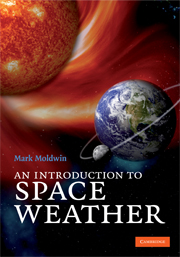Book contents
- Frontmatter
- Contents
- Preface
- Acknowledgments
- 1 What is space weather?
- 2 The variable Sun
- 3 The heliosphere
- 4 Earth's space environment
- 5 Earth's upper atmosphere
- 6 The technological impacts of space storms
- 7 The perils of living in space
- 8 Other space weather phenomena
- Appendix A Web resources
- Appendix B SI units
- Appendix C SI prefixes
- References
- Historical bibliography
- Index
- Plate section
8 - Other space weather phenomena
Published online by Cambridge University Press: 05 June 2012
- Frontmatter
- Contents
- Preface
- Acknowledgments
- 1 What is space weather?
- 2 The variable Sun
- 3 The heliosphere
- 4 Earth's space environment
- 5 Earth's upper atmosphere
- 6 The technological impacts of space storms
- 7 The perils of living in space
- 8 Other space weather phenomena
- Appendix A Web resources
- Appendix B SI units
- Appendix C SI prefixes
- References
- Historical bibliography
- Index
- Plate section
Summary
There is good evidence that within the last millennium the sun has been both considerably less active and probably more active than we have seen it in the last 250 years. These upheavals in solar behavior may have been accompanied by significant long-term changes in radiative output. And they were almost certainly accompanied by significant changes in the flow of atomic particles from the sun, with possible terrestrial effects.
Eddy, J. A. Science, 192, 1189–1202, 1976.Key concepts
global climate
asteroid impact
supernova
Introduction
Can space weather have ismpacts on global climate? We know that the amount of energy striking Earth from the Sun is the main driver of weather and climate. Temperature differences from day to night and from season to season are explained by the intensity of sunlight falling onto the surface and into Earth's atmosphere. For the most part, variation in intensity of sunlight is due not to changes in the luminosity or brightness of the Sun, but instead due to the daily rotation of Earth and the regular annual variation in hemispheric tilt toward or away from the Sun. In northern hemisphere summer, the Earth's axis and the northern hemisphere are tilted toward the Sun. Six months later, northern hemisphere winter occurs – Earth is on the opposite side of the Sun, and the northern hemisphere is tilted away from the Sun.
- Type
- Chapter
- Information
- An Introduction to Space Weather , pp. 112 - 122Publisher: Cambridge University PressPrint publication year: 2008

